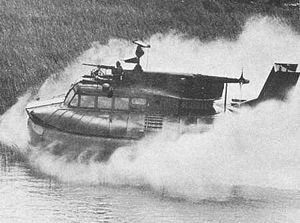- Patrol Air Cushion Vehicle
-
"PACV" redirects here. For the airport in Alaska with that ICAO code, see Merle K. (Mudhole) Smith Airport.

PACV cruising through swamp areaClass overview Name: PACV Builders: British Hovercraft Corporation, Bell Aerosystems Completed: 3 General characteristics Type: hovercraft Displacement: 7.06 metric tons Length: 38 ft 10 in (11.58 m) Beam: 23 ft 9 in (7.01 m) Installed power: 1014 hp Propulsion: GE LM-100 gas turbine Speed: 60 kn (110 km/h) maximum Range: 165 nmi (306 km) Complement: 4 Armament: .50 cal M2 machine gun, 2x M60 machine guns  USS Gunston Hall (LSD-5) (Dock Landing Ship) launches a PACV circa 1967
USS Gunston Hall (LSD-5) (Dock Landing Ship) launches a PACV circa 1967
The Patrol Air Cushion Vehicle (PACV) was a United States Navy river patrol hovercraft used during the Vietnam War.
The PACV was based on Bell Aerosystems Bell SK-5 hovercraft; a licensed version of the British Saunders-Roe (later, British Hovercraft Corporation) SR.N5 hovercraft. The SK-5 was adapted for American military use in 1965. Three were purchased by the U.S. Navy for operations in the emerging Vietnam War. Training of PACV crews was performed in the waters off Coronado, California near San Diego. Feedback from the training period allowed refinements to the design to be made.
Contents
Service
PACVs were first deployed in 1966 to Vietnam as part of the U.S. Navy's River Patrol Force (Task Force 116). Often called "Pac Vees", they were armed with a .50 caliber machine gun mounted on a rotational platform in the front, side mounted M60 machine guns, and often remote controlled M60s or grenade launchers in the stern. In addition, the crew, and often U.S. Army Green Berets and ARVN Rangers, riding on the side panels, employed assorted small arms such as M16 rifles, M79 grenade launchers, various other rifles, .45 pistols, M60s, and grenades. During PACV's first tour in Vietnam some basic light armor was added to the hovercraft to give it some protection from enemy fire. PACVs conducted many successful missions on the Mekong Delta, Cat Lo, Plain of Reeds out of Moc Hoa in their initial tour.
The Navy withdrew the PACVs for overhaul in December 1966/January 1967 and redeployed them to Vietnam in late 1967. The U.S. Army created its own version of the PACV in 1967 with some of the Navy's modifications from the experimental phase of 1966, calling it the ACV, for air cushion vehicle. There were only three Navy PACVs, and three Army ACVs during the whole Vietnam War.
The PACV was too loud for patrol and interdiction missions on the coastline and waterways. However, after "Operation Quai Vat" (Vietnamese for "Monster", which was what the Viet Cong called the PACVs) the PACV showed great prowess and capability in marshy terrain like the Plain of Reeds along the south Vietnamese/Cambodian border.
In Operation Quai Vat in November 1966, the PACV force brought its speed and firepower to bear on the Viet Cong, with many successful attacks and raids, taking prisoners and destroying Viet Cong sanctuaries. Afterwards, the success of operation Quai Vat formed the basis for stationing the Army's ACVs in the Plain of Reeds. It was found that the PACVs could move faster over the slick ground found in southwestern Vietnam, and over the border into Cambodia. Though the loud noise of the PACVs was still an issue, their speed made up for it in this otherwise difficult terrain, especially during the monsoon season. The search and destroy raids conducted out of Moc Hoa in November 1966 caught the Viet Cong by surprise and resulted in many Viet Cong deaths. With time, and the degree of threat that this new fast and fierce weapon brought with it, the handful of PACVs and ACVs in Vietnam became major targets for the insurgents.
The Green Berets out of Moc Hoa became proponents of the PACV, being involved in many of their early operations.
Survivors
PACV serial number 004 is the only surviving British Hovercraft Corporation-built US Navy PACV, and is currently preserved at the Bellingham International Maritime Museum.[1] The last surviving Army ACV (No. 903) is located at the Army Transportation Museum in Ft. Eustis, VA.
References
External links
Categories:- Hovercraft
- Riverine warfare
- History of the United States Navy
- Vietnam War ships of the United States
- Small combat vessel classes
Wikimedia Foundation. 2010.
